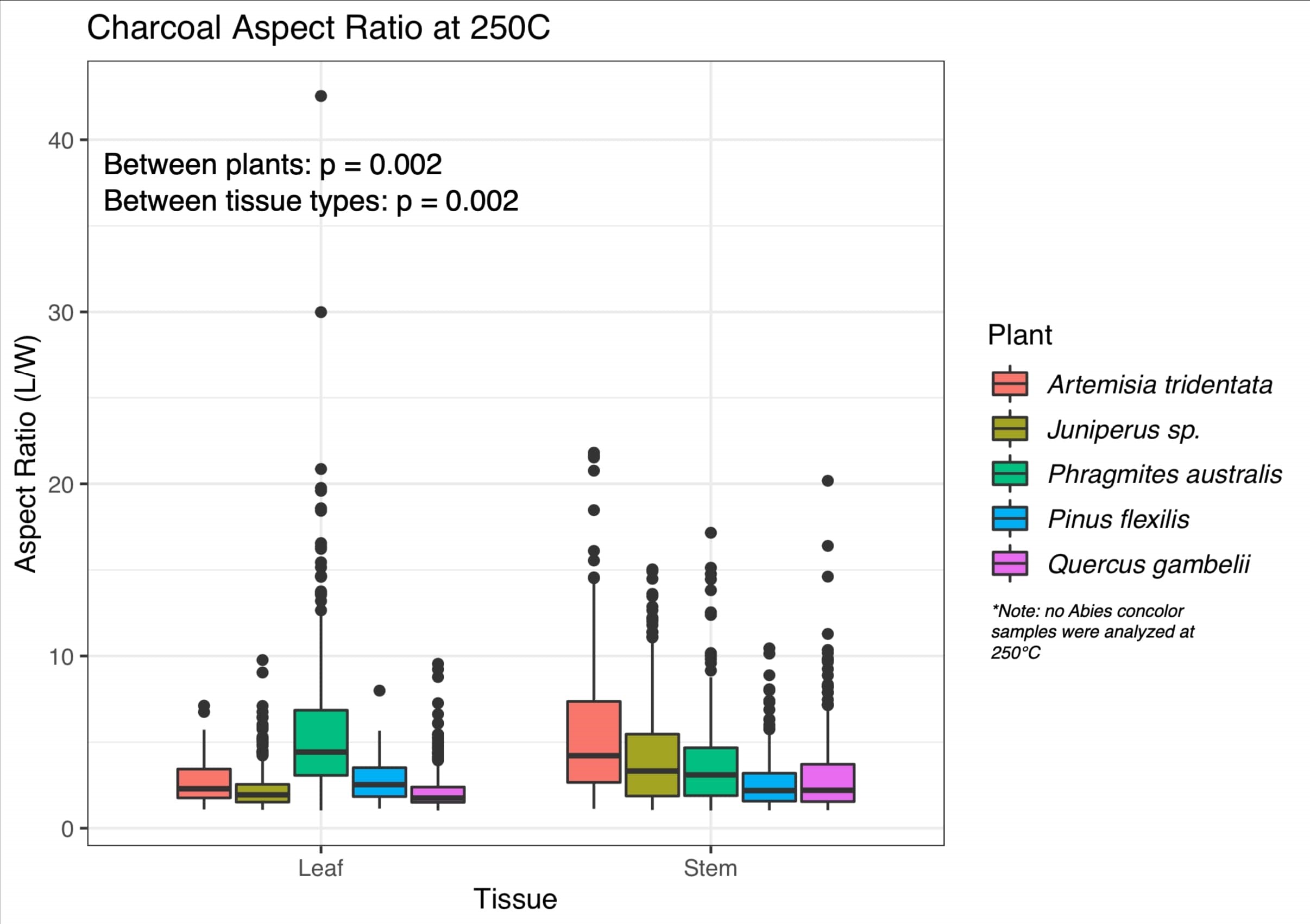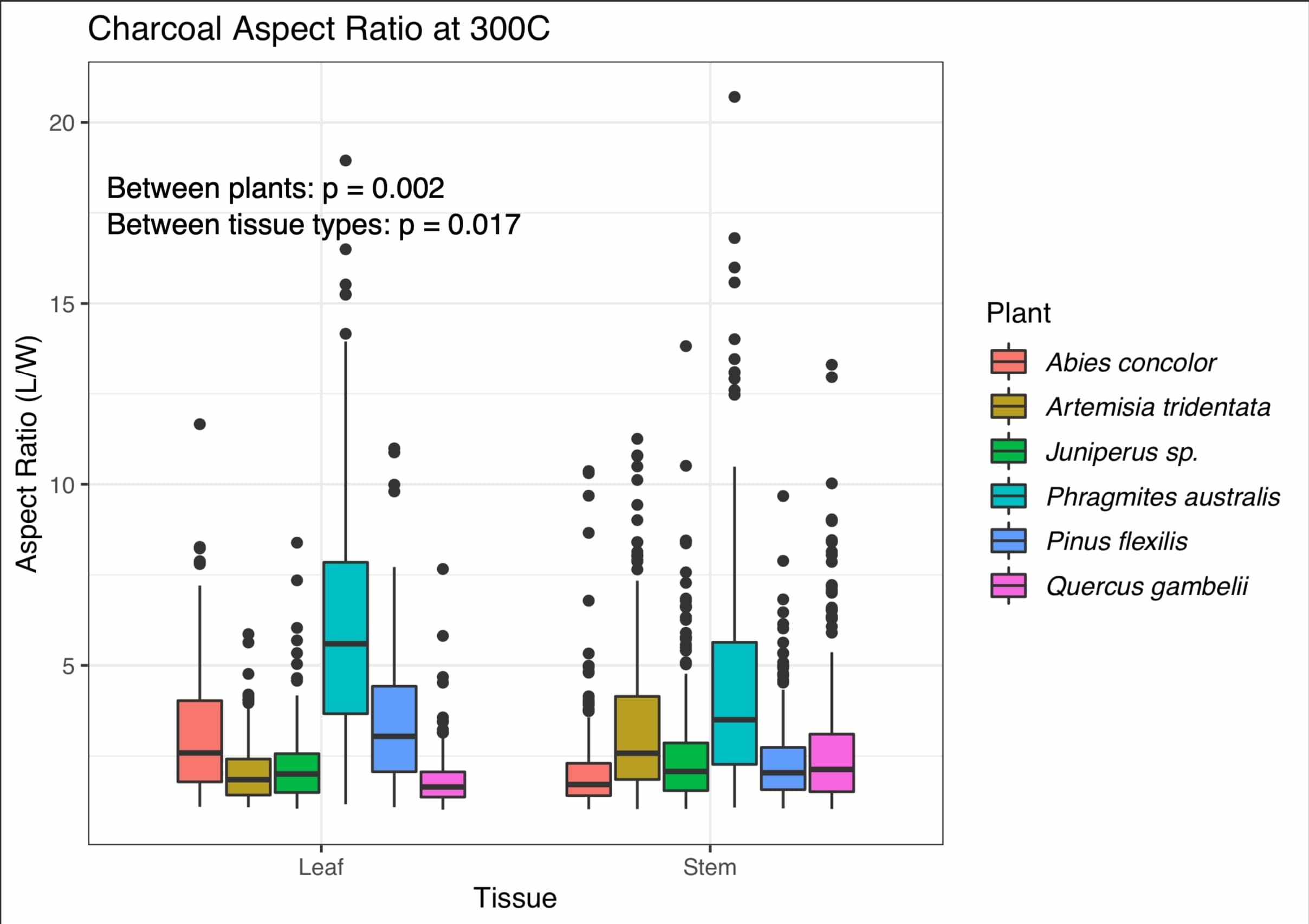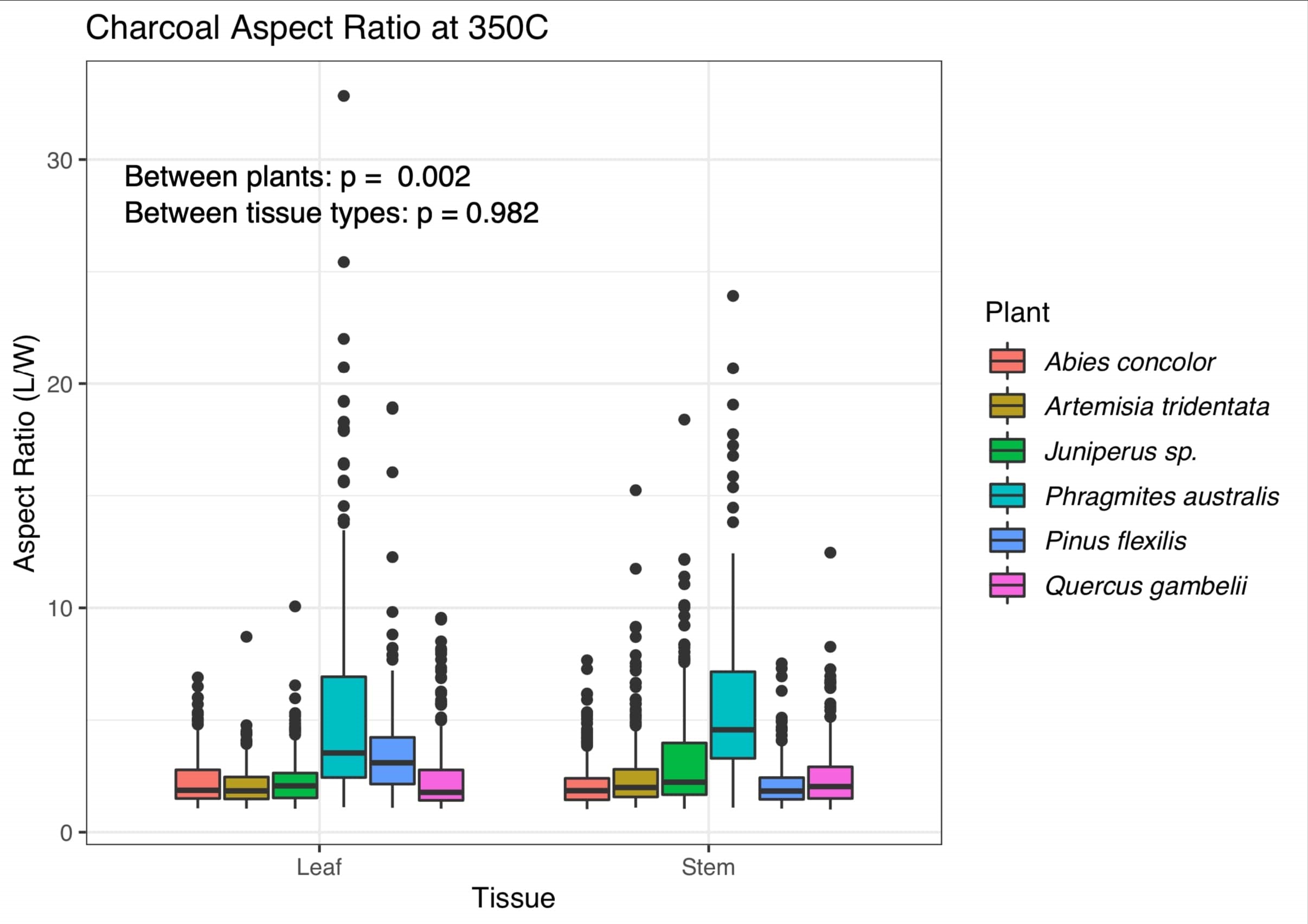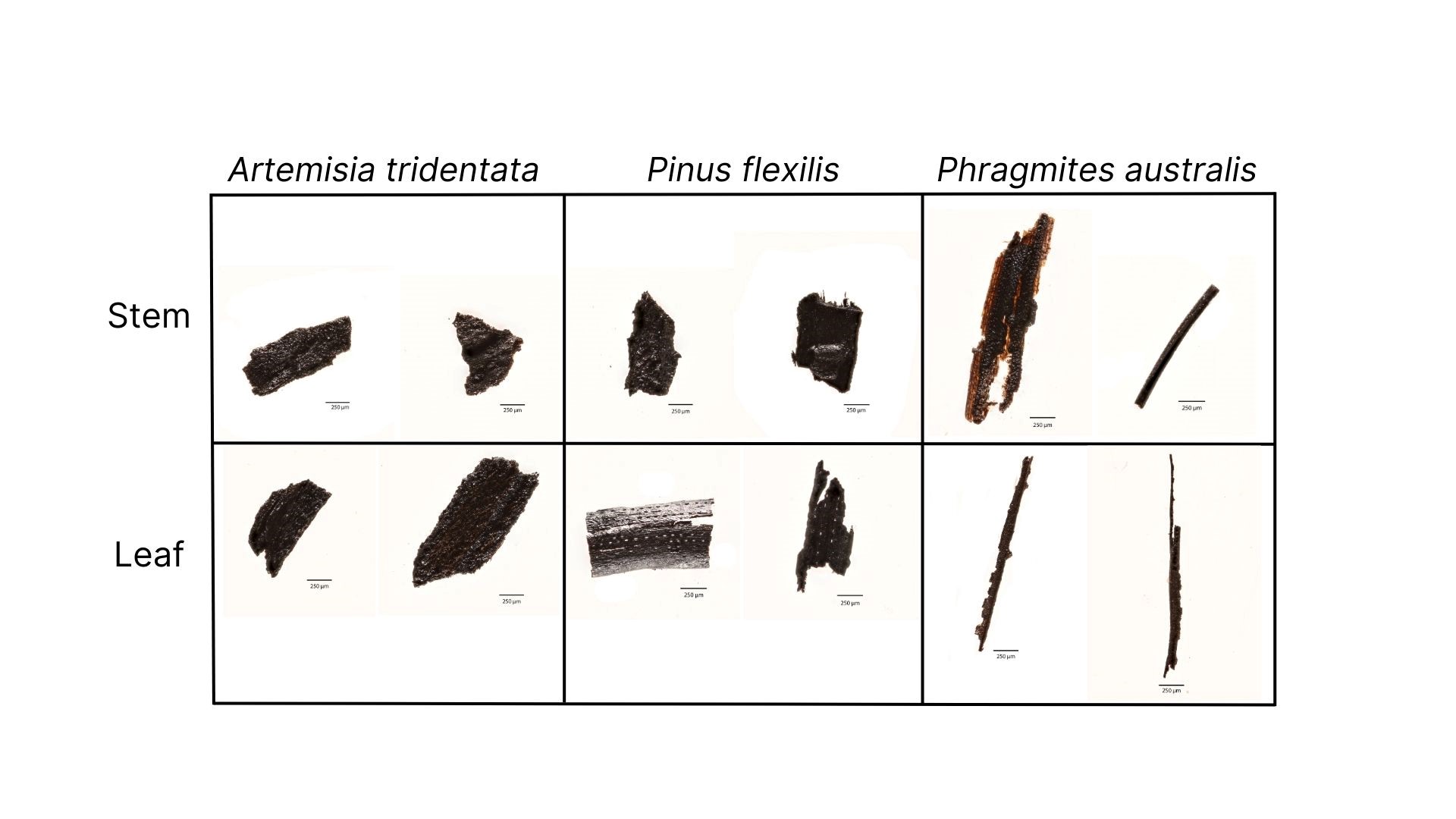Social and Behavioral Science
127 Analysis of Charcoal Morphometrics from Known Utah Plants May Inform Fire and Vegetation History Reconstructions
Amy Harvey; Stella Mosher; and Mitchell Power (Geography)
Faculty Mentor: Stella Mosher (Geography, University of Utah)
Abstract
Fire is one of the major forces that influences vegetation type and ecosystem dynamics of an area. Reconstructing past fire regimes can help us understand not only about the type of plants that were once in an area and how they responded to fire, but also how best resource and landscape management practices can be employed to preserve present ecosystems under a changing climate. This research contributes to the reconstruction of a fire history record from Utah. A newly emerging method, the study of charcoal morphology (shape) and morphometry (particle geometries) is increasingly being used to determine the types of vegetation that have burned. Charcoal morphotypes may provide insight into the fuel type burned, and measured geometries produced by the experimental burning of plant material at a range of combustion temperatures may provide insight into fire intensity. In this research, charcoal particles collected from experimental burning of modern plant reference material were analyzed to later be compared to the morphometric analysis of macroscopic charcoal particles from local lake sediments to understand vegetation change around Utah. At each temperature (250°C, 300°C, and 350°C) there was a significant (p < 0.05) morphometric difference between each type of plant, so morphometries likely can be used to identify vegetation type of fossil charcoal. Additionally, grass-type vegetation produced charcoal that was significantly elongated compared to woody vegetation. These findings may shed light on metrics of interest to the paleofire community, such as vegetation change, wildfire temperature, and wildfire intensity.
Introduction
Past research has found that measuring aspect ratios, defined as length:width (L:W) ratios of macroscopic charcoal particles, can serve as a proxy for the fuel type burned (Feurdean, 2021; Vachula et al., 2021). Evidence suggests that some morphologies vary significantly between different plant types, specifically between grassy fuel types, signified by unitless aspect ratios greater than 3.5, and woody fuel types, signified by aspect ratios less than 2.5 (Vachula et al., 2021). Using known, modern vegetation sampled from around Utah will help to better calibrate how charcoal particles are interpreted in the deep time record by determining the shapes and aspect ratios each type of plant tends to create, then exploring whether there are significant differences between plant types or between different tissues from the same plant, such as stems and leaves, and between different combustion temperatures.
The study site chosen was the Wasatch region of Utah. Five common species were collected from Little Cottonwood Canyon: white fir (Abies concolor), big sagebrush (Artemisia tridentata), juniper (Juniperus sp.), limber pine (Pinus flexilis), and gambel oak (Quercus gambelii). Common reed (Phragmites australis) was collected from within the Salt Lake Valley, near a water source in West Jordan. Findings can be used to directly compare to charcoal particles from fire history samples dating back thousands of years and contribute to the developing significance of charcoal morphometry in determining past fire history.
Methods
Abies concolor, Artemisia tridentata, Juniperus sp., Pinus flexilis, Phragmites australis, and Quercus gambelii samples were pressed and dried at the Natural History Museum of Utah. One-centimeter sections of both stem and leaf of each species were burned in a muffle furnace for two hours at temperatures of 250°C, 300°C, and 350°C. Samples were also burned at temperatures of 400°C and 450°C, however insufficient charred material remained for analysis. Most of the plant material burned at these temperatures turned to ash, suggesting full combustion of most plant material at higher burn temperatures. Charred samples were then processed by lightly crushing material to mimic natural transport and mechanical breakage, and then strained with water through a 125 µm sieve (Feurdean, 2021).
Charcoal fragments were measured using CharTool, a software package that uses machine learning to measure individual charcoal particle geometries through a Zeiss stereomicroscope at the University of Utah Records of Environmental Disturbance Lab. CharTool measures a range of particle geometries, including area, perimeter, roundness, and aspect ratio (L:W) (Snitker, 2020). This research focused on aspect ratio data which were measured comparing leaf and stem (typically, woody) tissue type for each species at 250°C, 300°C, and 350°C. Charred particles were quantified to about 250-300 pieces per sample, and morphometric data was exported as a .csv file for further analysis of species, tissue type, and temperature. Aspect ratio findings were then analyzed in R.
A novel technique using tangential flash macrophotography, developed at the Natural History Museum of Utah, was used to take high-resolution surface morphology photographs of select experimentally burned charcoal. This technique takes a series of images, which are then stacked, resulting in a limited depth of field but highlighted surface morphology. A Canon R5 mirrorless camera with a 65mm macro lens set at 5X magnification provided a field-of-view covering 7.2 mm by 4.8 mm with an effective magnification of 400X.
Results and Discussion
Experimental Burning and Morphometric Analyses
While measuring morphometrics with CharTool, typical shapes of each species quickly became apparent. For example, Pinus flexilis charcoal particles were typically slightly elongated and sometimes porous, Phragmites australis particles were extremely elongated and “stick”-like, and Artemisia tridentata particles were typically square and irregular block-like shapes. One weakness of the program is that it can only calculate geometries by tracing the perimeter of the charcoal particle, so nuances such as pores in the charred material or 3-dimensional shapes are not taken into account, although they may be meaningful indicators of some types of plant material.
Phragmites australis charcoal tended to have more variation within itself, likely because there were many long, curved, string-like pieces that may have skewed the data, and an analysis excluding outliers may provide more insight. Quercus gambelii, Pinus flexilis, and Abies concolor typically produced blocky charcoal with very uniform aspect ratios, leading to the conclusion that woody species often have low, uniform aspect ratios.
Charcoal aspect ratios analyzed for statistical significance at 250°C (Figure 1), 300°C (Figure 2), and 350°C (Figure 3) reveal intriguing trends. The most variation in aspect ratio among all plants was when burned at 300°C (Figure 2), whereas at 250°C (Figure 1) and 350°C (Figure 3) Phragmites australis was the main source of variation. It is important to note that variation in aspect ratio is highly significant (ANOVA, p < 0.05) at each temperature between each type of plant, and between tissue types at both 250°C and 300°C. Variation in aspect ratio was not significant between tissue types at 350°C (ANOVA, p = 0.982). Because of this overall statistical significance, morphometries can likely be used as a calibration tool for identifying vegetation type from fossil charcoal.
Figure 1. Experimentally charred morphometric measurements for Utah plants burned at 250°C.

Figure 2. Experimentally charred morphometric measurements for Utah plants burned at 300°C.

Figure 3. Experimentally charred morphometric measurements for Utah plants burned at 350°C.

High-resolution charcoal photography
The tangential flash macrophotography pictures captured at the Natural History Museum of Utah (Figure 4) show clear images that exemplify typical morphologies of Artemisia tridentata, Pinus flexilis, and Phragmites australis. CharTool measurement results align with these photographs; for example, Phragmites australis charcoal is elongated, showing a higher aspect ratio, and Artemisia tridentata and Pinus flexilis charcoal pieces are more blocky and round, showing a lower aspect ratio. These photographs also display pores, 3-dimensional features, and lighter areas that did not completely char, something that CharTool analysis does not capture.
Figure 4. Photographs taken at the Natural History Museum of Utah of charcoal pieces of both stem and leaf of Artemisia tridentata, Pinus flexilis, and Phragmites australis burned at 350°C.

Conclusion
This work suggests that significant differences may exist between plants and tissues at different temperatures which could help us understand what was burning when reconstructing fire histories. If paired with pollen analyses, this information would bolster interpretations of vegetation change over time. To better understand what charcoal morphometrics can tell us about the fire history of an area, the methodology described needs to be continually tested for other species, other temperatures, and other plant tissue types and compared with fossil charcoal found in sediment cores.
References
Feurdean, A. (2021). Experimental production of charcoal morphologies to discriminate fuel source and fire type in the Siberian taiga. Biogeosciences.
RStudio Team (2020). RStudio: Integrated Development for R. RStudio, PBC, Boston, MA URL http://www.rstudio.com/
Snitker, G. (2020). A Charcoal Quantification Tool (CharTool): A Suite of Open-source Tools for Quantifying Charcoal Fragments and Sediment Properties in Archaeological and Paleoecological Analysis. EBL 11, 103-15. https://doi.org/10.14237ebl.11.1.2020.1653
Vachula, R. S., Sae-Lim, J., & Li, R. (2021). A critical appraisal of charcoal morphometry as a paleofire fuel type proxy. Quaternary Science Reviews.

